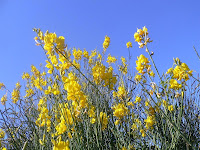The name of the fifth month of the Julian calendar, the month of May (in Latin, Maius and Maio, in Portuguese language) probably had its origin in the word Maia, the mother of Mercury.
In Roman tradition, Maia personified the awakening of nature in the spring and is also the goddess of fertility and the projection of vital energy. Maia is symbol of spring.
In Portugal it is a tradition to decorate the doors of houses and windows and other places with common gorse flowers. The tradition requires that the locks and latches on all windows and external doors of the houses are decorated with branches of gorse in bloom, called "Maia". Farmers should also be vigilant and place the flowers inside the animal corrals.
If doors or windows do not hold a branch of Maia, it is believed that "the devil will come and suck the blood of those who dwell there."
This is a very old tradition throughout Portugal, especially in the north. Some scholars say it has to do with pagan rites associated with spring and fertility of the land and animals. There are also those who say that this tradition may have religious roots as as story goes that Our Lady, during her the flight into Egypt, with Baby Jesus and Saint Joseph, had sowed gorse seeds along the way so that they could find their way back when returning from there.
Another legend goes that by the time of Passover, when Jesus was in Jerusalem, the Jews marked with gorse branches the house where he was staying so that the soldiers could identify it later on and arrest him. However, on the next day, all doors and windows of the city were decorated with flowers of gorse, making it impossible for the soldiers to find Jesus's location.
In the Alentejo region, with particular emphasis on Beja, the "Maia" are girls who dress in white, adorned with flowers in their heads. They gather on the streets and sit on chairs adorned with roses while other elder girls carrying small trays in hand, ask passers-by : "Sir, give some money for the Mayan." - “Meu senhor, um tostãozinho para a maia"
In the Algarve, in almost all the houses it is customary to get a big man made of straw, rye, bran and rags and dress it in white and then surround it with flowers. It is the "Maia" placed in full view of passers by.
This habit of putting yellow gorse at the doors, windows and balconies is not lost, as well as the enduring habit of making straw dolls. However, the tradition of girls dressed in Maia has become rare nowadays. However, on the first day of May, there are other traditional rituals such as eating chestnuts with the aim of cast the evil away.
Some nice vocabulary to prepare you for the Maia Rituals:
Flower - flor
Gorse - giestas
Bunch - ramalhete
Door - porta
Window - janela
chestnuts - amêndoa
Spring - primavera









